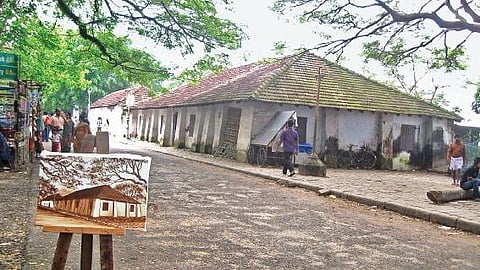

KOCHI: Numbered 1/1 by the civic body, Laurel Club, housed in a building known as ‘Karippura’ in Fort Kochi, was considerably elitist, often frequented by the British highbrow society. The building, marked by Dutch architecture, was perhaps the first to witness ships heralding the arrival of the ‘unfamiliar’ to Kochi. The evolution of ships and the lingering of spices exchanged permeated the area until the port was shifted to Willingdon Island.
Last year, the centuries-old building became one of the three heritage structures demolished to make way for the Water Metro. Though it shattered history into a zillion shards, 1/1 continues to live through a monochromatic work painted by 54-year-old artist Dinesh R Shenoy in 2012. Since 2004, the Mattanchery-native has documented over 450 historical landmarks, through his sepia-toned oil paintings.
The artist’s works, celebrating Kerala’s heritage structures, can be found adorning the walls of historically renowned buildings including the Dutch Palace Museum in Mattancherry and Arakkal Palace in Kannur. All of Dinesh’s paintings are single-toned in burnt umber, which has now emerged as his signature style. “The choice wasn’t exactly conscious; back in the day, I could not afford to buy different hues of oil paint tubes, due to its expensive nature. One colour was all I could get my hands on. It eventually evolved into my trademark and I’ve continued to sketch and paint in burnt umber,” says Dinesh.
His rendezvous with historical architecture have a cause too. “A majority of the buildings in my paintings have been bulldozed, they no longer exist. I’ve had people visiting my gallery ‘Chitrasala’ in Mattanchery, solely to see them. The first building I documented was SN Hospital in Kochi in 2004, which was demolished later. Ever since I’ve been on a spree to paint antique buildings. History must be preserved in some form. Since the demolishing of buildings is not in our control, conserving the same as pure oil paintings will extend their life longer,” he explains.
Mostly done as Plein air paintings, Dinesh takes around eight to ten days to complete one piece of work. A major portion of these landmarks constitutes mosques. “I’ve been teased in my area as the man who paints soon-to-be-demolished buildings. While I’ve casually stumbled upon some, many people let me know if they want a heritage structure painted or if a historically important building will be pulled down,” says Dinesh.
Starting big
The artist has no formal education in art, instead, he tried his hand at the same in 1982 and then learnt the nuances of oil paintings for a year under the tutelage of artist Joseph Newton who reluctantly asked the boy to ‘observe and learn’. In no time, the quick learner began taking oil painting classes for affluent families in Kochi.
“Almost all of my students were older than me. I purely dealt with oil painting, which was a pricey hobby and a trend during the time. In 1992, parents were hesitant to spend that amount on this specific genre of painting for their children. As a result, I taught elder women and in a few institutes. Also, I’ll always be a stranger to watercolour. To me, it requires proper training, which I haven’t received,” shares Dinesh.